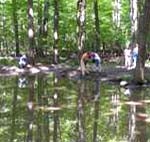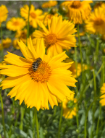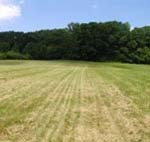The Conservation and Green Initiatives programs continue to expand at the farm. Projects are aimed at enhancing the farm's natural resources while providing great opportunities for research and teaching for students and farm visitors.
Since 2000, several programs have been established, including a bluebird trail of 58 houses, a four-acre prairie restoration, enhancement of ponds using renewable energy, and the creation of a salamander lagoon. In January 2010, a pilot program was initiated to grow food at the farm for the campus dining rooms.
BlueBird Trail
The BlueBird Trail consists of 58 birdhouses along the cross-country trails and research ponds. The area offers an ideal environment for breeding, due to the low grass surrounding the area and plentiful water resources. Over the years, the trail has produced abundant wildlife.
Volunteers check the houses regularly during the breeding season (April to August), record the data, and band the hatchlings, which include bluebirds, tree swallows, and house wrens.
Salamander Lagoon
The Salamander Lagoon was created in the north woodlots to increase the abundance and diversity of salamander at the farm.
Two herpetologists, Dr. Martin Rosenberg from the Department of Biology and Dr. Tim Matson from the Cleveland Museum of Natural History, are involved in the project and its continued expansion. Dr. Matson has been introducing wood frogs and spotted salamanders into the lagoon for the last several years. Additional farm research is ongoing.
Native Pollinator Garden
Developed and installed in 2023 as part of his Eagle Scout project, Chase Fulton created the Native Pollinator Garden between the Honey House and A.I. Root Apiary. Native species include: blue wild Indigo, yarrow, lanceleaf coreopsis, common milkweed, coneflower, asters, black eyed susans, lupine and columbine.
Prairie Restoration Project
The Farm's prairie restoration project began in the spring of 2006 with the goal of restoring four acres of old pasture area into a native prairie containing several Ohio indigenous grasses and twenty forbs species. Surveys during the last few years show a consistent presence of several early prairie forbs.
During spring and summer 2009, 17 wildflowers and grasses were observed in the prairie restoration area. The project is enhancing the farm's rich wildlife and becoming another teaching and research tool to complement the farm's expanding academic programs.





